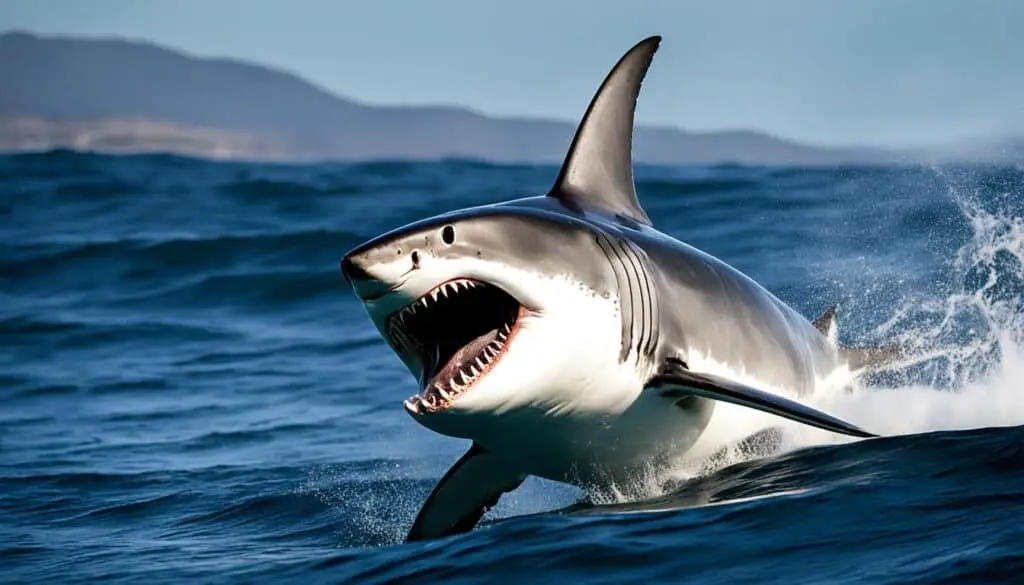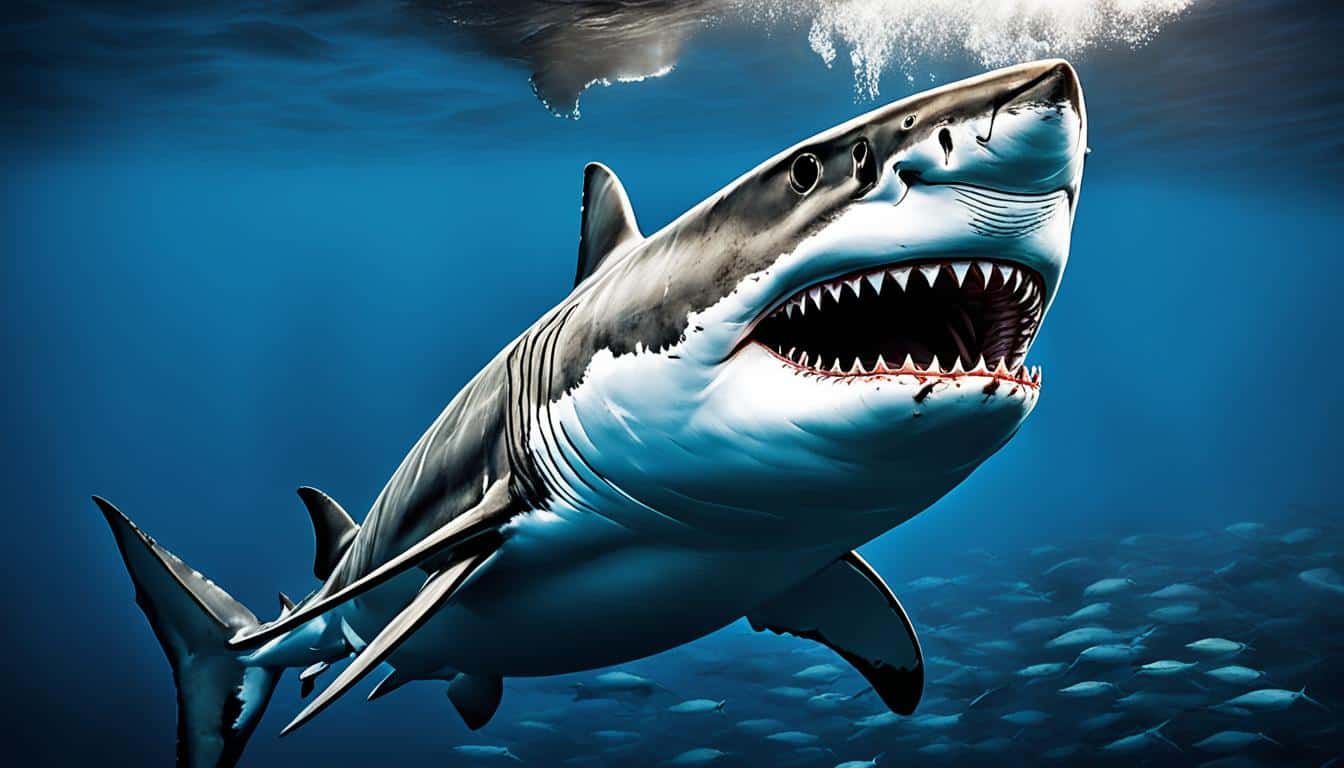Welcome to the fascinating world of sharks. Here, you’ll learn about their hunting skills in different water environments. These amazing creatures have natural abilities that help them catch prey. They use various hunting behaviors and techniques suited to their habitats.
This article will take you on a journey to discover the complex ways sharks hunt. You’ll see how they are unmatched in finding food in the wild. Let’s dive into the world of shark hunting strategies.
Understanding Shark Hunting Behavior
To understand shark hunting behavior, we must look at their diverse hunting methods. These amazing creatures use a mix of strategies that show how they’ve adapted over time. By studying these behaviors, we learn how they hunt in different places.
Types of Predatory Techniques
Sharks use many hunting techniques, each suited to their environment and prey. Here are some common ones:
- Ambushing: Many sharks surprise their prey to catch them off guard.
- Stalking: Some sharks sneak up on their prey without being seen.
- Collaboration: Some sharks hunt together, which helps them catch prey more often.
Importance of Environment in Hunting
The environment greatly affects shark hunting. Different places like reefs, kelp forests, and open waters offer both chances and challenges. For example, murky waters help bull sharks sneak up on prey unseen. This shows how important their surroundings are to their hunting.
How Do Sharks Hunt?
Sharks are known for their amazing hunting skills. They use different strategies based on their environment and prey. These strategies make them stand out in the ocean. They show how hunting methods can vary among shark species.
Common Shark Hunting Strategies
One common way sharks hunt is the “bump and bite” technique. They use their strong bodies to hit their prey. This helps them figure out what it is and disorient it. Sharks are also fast and agile, chasing fish in schools and catching them off guard.
They can even smell out potential food from far away. This helps them find their next meal.
Unique Hunting Methods of Different Species
Each shark species has its own way of hunting. For example, hammerhead sharks have special sensors called ampullae of Lorenzini. These let them find prey hidden under the sand by detecting electric fields.
Some sharks hunt together, using their strength to catch prey. This shows how sharks have evolved different ways to hunt.
Shark Feeding Habits and Diet
Sharks play a key role in their ecosystems thanks to their varied feeding habits. They can live in both saltwater and freshwater, showing their adaptability. Their diet changes with their environment, affecting their looks and actions.
Saltwater vs. Freshwater Diets
Sharks in saltwater eat mainly:
- Bony fish
- Stingrays
- Mollusks
In freshwater, sharks eat different things. Their diet might include:
- Crabs
- Turtles
- Land animals such as birds and small mammals
This shows how their diet changes with their environment. Sharks are top predators in many ecosystems thanks to their adaptability.
Opportunistic Feeding of Bull Sharks
Bull sharks are known for eating whatever they can find. They live in both salt and freshwater, eating a variety of foods. This includes:
- Fish
- Invertebrates
- Small terrestrial animals
This way of eating helps bull sharks survive and have a big impact on their environment. It lets them adjust to changes in their surroundings.
Shark Hunting Adaptations and Physical Traits
Sharks have amazing physical traits that help them hunt. Their bodies and senses are key to their hunting skills.
Skin Structure and Streamlined Bodies
Sharks have skin covered with tiny, tooth-like scales called dermal denticles. These scales help in two ways. They cut down on water resistance, letting sharks swim fast and quiet. Their bodies are also shaped to be agile, making quick turns during a chase.
Sensory Capabilities for Prey Detection
Sharks also have great senses to find prey. They can hear well and smell blood from far away. They can even feel electrical signals from prey with special organs called ampullae of Lorenzini. These senses help sharks hunt well, even in dark or unclear waters. Each trait shows how sharks are adapted for hunting in different places.

Shark Hunting Patterns and Strategies
Sharks have different hunting patterns based on their environment. They use various strategies to improve their hunting success. One key method is the bump and bite technique, seen in bull sharks. This lets them check out their prey before attacking.
Bump and Bite Technique Explained
The bump and bite technique is a mix of checking and attacking. A bull shark will bump into its prey to see its size and how it reacts. This helps the shark decide if it’s a good meal.
If it’s a good target, the shark quickly bites with all its might. This shows how important being aware and quick is in hunting.
Hunting in Murky Waters
Hunting in murky waters is tough for sharks because they can’t see well. But, it also lets them surprise prey. Bull sharks are great at this, using their strong sense of smell to find food.
They follow smells to find prey that doesn’t even know they’re there. This shows how sharks can adapt their hunting in different places.
Shark Predation Methods in Action
Sharks are fascinating predators that show us how they hunt. By watching them in the wild, we learn about their hunting skills. They use speed, stealth, and smarts to catch their food.
Great white sharks are known for their surprise attacks. They sneak up from below, hidden in the deep. Then, they burst up fast to catch seals by surprise. This shows how powerful their hunting is.
Hammerhead sharks have a special way of hunting too. Their unique heads help them find prey like stingrays hiding in the sand. This skill makes them very good at catching their food.
Underwater photos and videos show sharks hunting up close. These images prove how important sharks are in the ocean. They help us understand the complex life in the sea. By seeing their hunting, we learn about their amazing skills.
Conclusion
This article has taken a deep dive into shark hunting behavior. It shows how sharks hunt and their amazing skills. Sharks have evolved over millions of years to become top predators in the ocean.
Sharks use many hunting strategies to catch their prey. Their physical traits and hunting methods are key to their success. This makes them adaptable and resilient in different environments.
There are many types of sharks, each with its own way of hunting. Learning about their hunting habits helps us understand marine life better. It also shows how important sharks are for the ocean’s balance.
Sharks are crucial for the ocean’s health. That’s why we need to protect them. By supporting conservation efforts, we help ensure sharks will continue to thrive.
As you explore the ocean, remember the connection between sharks and their environment. By protecting their home, we help sharks and the ocean. This way, future generations can still marvel at these incredible hunters.
FAQ
How do sharks hunt?
Sharks hunt using various strategies like ambushing and stalking. They use their sharp senses and the “bump and bite” method to catch their prey.
What are the key predatory techniques of sharks?
Sharks have many hunting methods. They use stealth in murky waters, work together with others, and chase prey with their speed and agility.
How does the environment affect shark hunting behavior?
The environment greatly influences shark hunting. Reefs and kelp forests let them ambush. Murky waters help them sneak up on prey.
What are the common hunting strategies used by sharks?
Sharks often use the “bump and bite” method to check their prey before attacking. They also chase schooling fish and use their strong sense of smell to find prey.
Are there unique hunting methods among different shark species?
Yes, each shark species has its own way of hunting. For example, hammerhead sharks use special sensors to find prey under the sand.
What are the feeding habits of sharks in saltwater versus freshwater?
Sharks eat differently in saltwater and freshwater. In saltwater, they eat fish, stingrays, and mollusks. In freshwater, they eat crabs, turtles, and even birds and mammals.
How do bull sharks showcase opportunistic feeding behavior?
Bull sharks eat a wide variety of prey. They change their diet based on what’s available in different places.
What physical adaptations do sharks have for hunting?
Sharks have special features like skin with denticles that reduce drag, streamlined bodies for fast swimming, and advanced senses for finding prey.
What sensory capabilities enhance shark hunting instincts?
Sharks have great hearing, smell, and can detect electrical signals from prey. These abilities help them hunt in different conditions, even in dark or murky waters.
Can you explain the “bump and bite” technique?
The “bump and bite” technique means sharks first bump their prey to check its type and behavior. Then, they attack to catch their food.
How do sharks hunt in murky waters?
In murky waters, sharks use their smell and electroreception to find and catch prey. They surprise their prey to increase their chances of success.
What are some real-world examples of shark predation methods?
In the wild, sharks ambush prey using stealth, surprise, and speed. This shows how effective their hunting strategies are in real situations.







